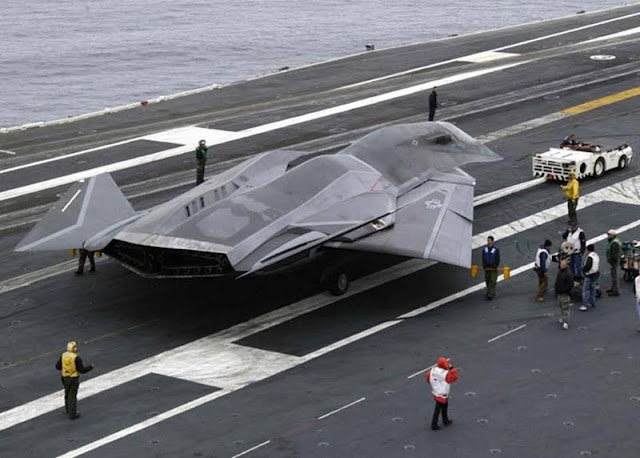The plane in these pictures is still officially the 'Air
Vehicle Number 1', a prototype, on board the USS George
Washington CVN-73 for catapult fit checks. Not exactly stillTop Secret but certainly not yet made public.
It will be known as the F/A-37. Although specs are
classified, it is believed to be Mach 3.5 (top speed in the
Mach 4 range), super-cruise stealth
fighter/ bomber/interceptor with approximately a
4,000nm range. Awesome!Vehicle Number 1', a prototype, on board the USS George
Washington CVN-73 for catapult fit checks. Not exactly stillTop Secret but certainly not yet made public.
It will be known as the F/A-37. Although specs are
classified, it is believed to be Mach 3.5 (top speed in the
Mach 4 range), super-cruise stealth
fighter/ bomber/interceptor with approximately a
Check out the Navy test pilot in the cockpit of the
F/A-37...LT Kara Wade
For the first time in over 20 some odd years, three carrier strike groups
From top to bottom are the aircraft carriers,
ABRAHAM LINCOLN, KITTY HAWK, and RONALD REAGAN.
We even had Air Force planes fly-over, see the B-2 Stealth Bomber in the
fifth & seventh picture down. The only warships not seen in the photos are
the 4 nuclear powered submarines standing guard. WOW!!
PACIFIC OCEAN, (June 18, 2006) - USS Ronald Reagan (CVN 76) (foreground),
USS Kitty Hawk (CV 63) (middle), USS Abraham Lincoln &n bsp;(CVN 72) and their associated carrier strike Groups steam in formation while 17 aircraft from the Air Force, Navy, and Marine Corps fly over them During a joint photo exercise (PHOTOEX) while preparing for exercise Valiant Shield 2006. The Kitty Hawk Carrier Strike Group is currently participating in Valiant Shield 2006, the largest joint Exercise in recent history. Held in the Guam operating area June 19-23, the exercise includes 28 Naval vessels including three carrier strike groups. Nearly 300 aircraft and approximately 22,000 service members from the Navy, Air Force, Marine Corps, and Coast Guard are also participating in the exercise.
OfficialU.S. Navy photo by Chief Photographer Mate Todd P.
Boeing is preparing a 1000 passenger jet that
could reshape the Air travel industry for the next
100 years. The radical Blended Wing design has
been developed by Boeing in cooperation with the
NASA Langley Research Center . The mammoth
plane will have a wing span of 265 feet compared
to the 747's 211 feet, and is designed to fit within
the newly created terminals used for the 555 seat
Airbus A380, which is 262 feet wide.
The Airbus A380 has been in the works since 1999
and has accumulated $13 billion in development costs,
which gives Boeing a huge advantage now that Airbus
has committed to the older style tubular aircraft for
decades to come.
There are several big advantages to the blended
wing design (Burnelli influence?), the most important being the lift to drag ratio which is expected to increase by an amazing 50%, with overall weight reduced by 25%, making it an estimated 33% more efficient than the A380, and making Airbus's $13 billion dollar investment look pretty shaky.











No comments:
Post a Comment